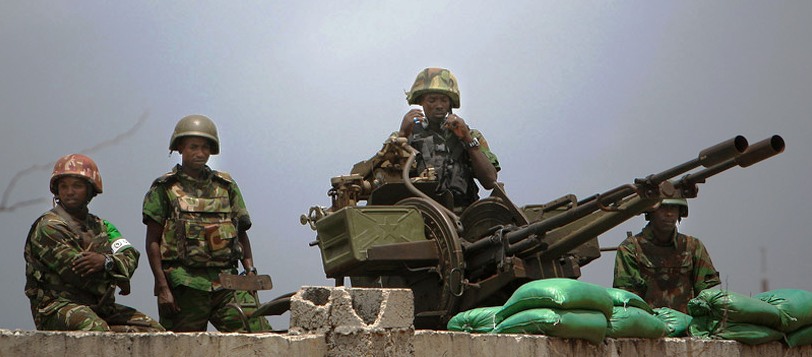Somalia: AU Forces Linked to Wedding Killings

(Nairobi, August 14, 2015) – African Union (AU) forces in Somalia (AMISOM) should impartially investigate the killing by alleged Ugandan army troops of six men at a wedding on July 31, 2015, in the Somali port town of Merka, Human Rights Watch said today. The investigation should be carried out with maximum protection for witnesses, and the Ugandan government should fairly prosecute any of its soldiers responsible for criminal offenses.
Witnesses told Human Rights Watch that following a bomb attack on an AMISOM convoy, Ugandan forces entered several nearby houses in Merka’s Rusiya neighborhood. At one house, where the Moalim Iidey family was celebrating a wedding, the soldiers separated the men from the women and shot the six adult men – four brothers, their father, and an uncle. Four died immediately, one brother hid under a bed after being shot but later died, and the father died during the night after the soldiers allegedly refused to allow the family to take him to the hospital.
“African Union forces in Somalia face difficult challenges, but that makes respecting the laws of war even more crucial,” said Maria Burnett, senior Africa researcher at Human Rights Watch. “Gunning down people at a wedding or anyone else in cold blood as punishment for insurgent attacks will only make things harder for the African Union forces in the future.”
Under international humanitarian law applicable to the armed conflict in Somalia, parties to the conflict, including troop-contributing countries to the peacekeeping force, have an obligation to investigate alleged war crimes by their forces or forces under their jurisdiction, and appropriately prosecute those responsible.
One witness told Human Rights Watch: “After the explosion everyone in that area ran, because people fear AMISOM a lot. I think the family thought they would be protected because they were celebrating a wedding and thought that would stop AMISOM from killing them. Instead AMISOM turned the wedding into bloody event.”
Those killed were Moalim Iidey Heyle, Omar Moalim Iidey, Yusuf Moalim Iidey known as “Bikole,” Hussein Moalim Iidey, Siid-Ali Moalim Iidey, and Aweys Hassan Hussein known as “Hamarow.”
In 2012, AMISOM troops supporting the Somali army helped retake Merka from the Islamist armed group Al-Shabab. AMISOM forces have remained, but Al-Shabab maintains control over large portions of surrounding rural areas of the Lower Shabelle region. The AMISOM forces now based in Merka are from the Ugandan People’s Defence Forces (UPDF).
AMISOM issued a news release on August 4 stating that its supply convoys had come under repeated attack by Al-Shabab in Merka and that its forces had responded “proportionately” in “self-defense.” The statement also said AMISOM would address allegations of civilian deaths and that the detachment commander had been recalled for questioning.
“AMISOM needs to carry out credible investigations into the events in Merka and elsewhere that would show Somalis that it is committed to holding abusive troops to account,” Burnett said. “The investigation needs to include more than questioning AMISOM’s own soldiers and it will require providing protection to witnesses so that all accounts can be heard.”
The other recent alleged killings of civilians by AMISOM forces in Merka should also be investigated, Human Rights Watch said.
Six witnesses told Human Rights Watch that on July 21, 2015, alleged AMISOM forces had killed at least 11 civilians, including a woman, two teenagers, and two elderly men, in separate incidents in the Jujuuma, Aw Balle, and Rusiya neighborhoods of Merka. AMISOM initially denied reports of civilian deaths and said that its forces had killed five Al-Shabab fighters during a patrol operation.
AMISOM carried out a preliminary investigation into the July 21 killings, and has since created a board of inquiry to look into both that and the July 31 incidents in Merka. None of the survivors of either incident interviewed by Human Rights Watch have yet been interviewed by AMISOM investigators.
Witnesses to both the July 21 and 31 incidents told Human Rights Watch that they feared reprisals from both Al-Shabab and AMISOM. Al-Shabab has executed civilians for allegedly assisting AMISOM forces. AMISOM leadership and troop-contributing countries will need to work carefully to ensure that witnesses who are interviewed are provided confidentiality and necessary security, Human Rights Watch said. This may involve bringing witnesses to Mogadishu and interviewing them in safe locations.
In addition to the AMISOM inquiry, the AMISOM spokesman told Human Rights Watch that a joint oversight committee made up of AMISOM and Somali government representatives will also be established to investigate the civilian deaths in Merka. A 2013 joint investigation into abuses by AMISOM forces in Mogadishu was marred by serious procedural flaws. For the joint committee to provide effective oversight, the Somali government should ensure that the work of the committee is transparent, includes competent personnel and gives priority to protecting witnesses, Human Rights Watch said.
The AU Peace and Security Council deployed the peace support troops known as AMISOM to Somalia in 2007 under a United Nations Security Council mandate. Since then, AMISOM’s mandate, size, and geographical presence have steadily increased. AMISOM is currently conducting a new offensive against Al-Shabab in several regions of south-central Somalia.
On July 28, 2015, the UN Security Council renewed AMISOM’s mandate until May 2016, in a resolution that largely failed to underscore the importance of accountability for abuses by AMISOM forces. The Security Council resolution, however, said the AU should share information gathered through its newly established Civilian Casualty Tracking Analysis and Response Cell with relevant stakeholders, including the UN.
“The military operations in south-central Somalia make accurate information and reporting on abuses against civilians increasingly urgent,” Burnett said. “The willingness of AMISOM and troop-contributing countries to allow scrutiny of their conduct will be indicative of their commitment to accountability.”